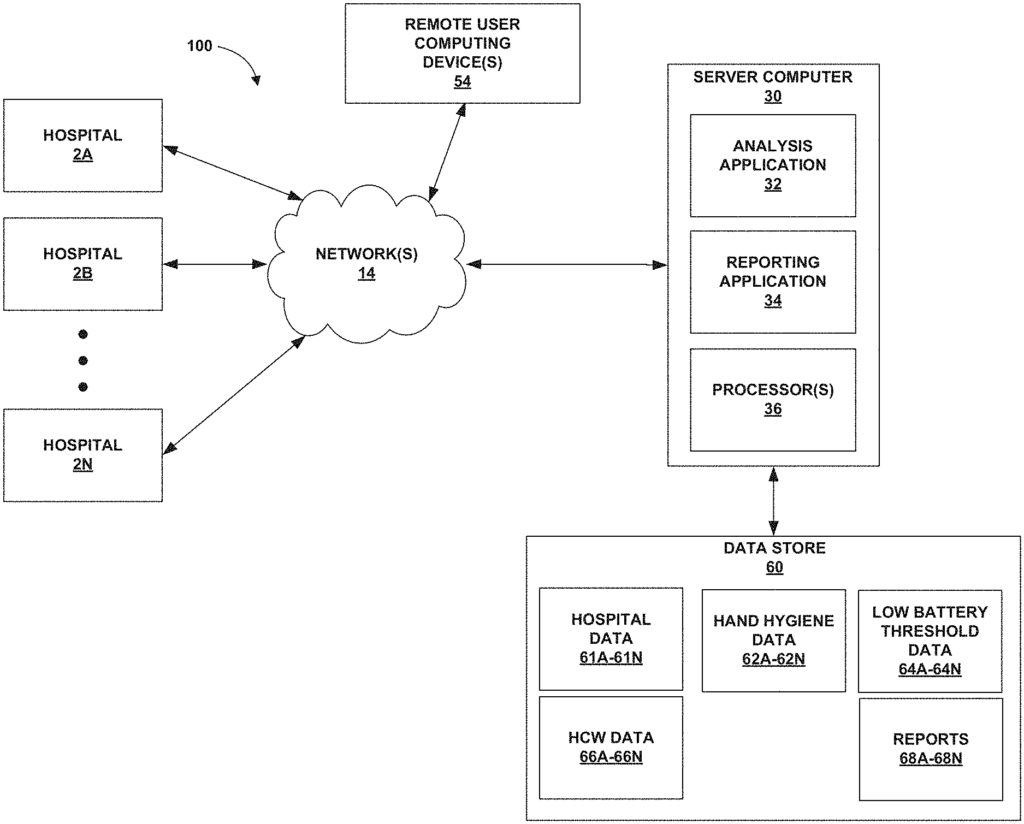Invented by Joseph P. Erickson, Viktor Slobodyan, Ecolab USA Inc
The Ecolab USA Inc invention works as follows
The systems and methods of detection and analysis for battery condition information can be applied to battery-powered hand hygiene product dispensers, for instance. Battery condition information can be used to determine potential low battery conditions and to identify the type of dispenser or product that was dispensed. It may also be used to detect the occurrence of battery replacement events in a dispenser for hand hygiene products. Battery condition information can also be used to determine the number of dispensations left for a dispenser. Battery condition information can also be used in hand hygiene compliance system to determine the battery condition of battery-operated hand hygiene product dispensers.
Background for Detection of battery condition in dispensers for hand hygiene products
The most effective way to reduce the spread of pathogens in healthcare settings is for health care workers to follow hand hygiene guidelines. Hand hygiene compliance is still low and improvements are not sustainable.
The disclosure is primarily concerned with the detection and analysis battery conditions of battery-powered devices. Battery condition detection techniques can be used to detect low battery conditions or provide battery information for hand hygiene dispensers that are powered by batteries. Battery condition information can also be used to identify the type of dispenser or product that was dispensed and/or detect an event of battery replacement. Battery condition information can also be used to determine the number of dispensations left for a dispenser that dispenses hand hygiene products. Battery condition detection techniques can also be used to determine the battery condition of battery-operated hand hygiene product dispensers within hand hygiene compliance systems.
The disclosure in one example is directed at a system that includes a plurality dispensers, each configured for dispensing a hand-hygiene product. Each dispenser has an associated dispenser type as well as an associated dispensed products type.
The disclosure also includes a system that comprises a hand-hygiene product dispenser that is associated with one type of dispenser and is configured to dispensing a product; a voltage sensor which senses voltage data correlated with a battery voltage; a hand-hygiene product dispenser that transmits dispenser data that includes dispenser identification information, one of a number of associated dispenser types, and voltage information; a data storage medium that stores a set of low battery levels, each of which corresponds to one of
The disclosure also includes a system that includes a hand-hygiene product dispenser with one or multiple batteries that are configured to provide power to the dispenser. It also includes a voltage sensor which senses voltage data correlated to battery voltage; the hand-hygiene product dispenser is configured to transmit voltage information; a data storage medium that stores one low battery threshold corresponding each to a dispenser, and that contains a number of discharge profiles, each of which corresponds to one of several dispenser types; a computing device
The disclosure also includes a system that comprises a hand-hygiene product dispenser that is defined by a single type of dispenser and that has one or multiple batteries to power the dispenser. This hand-hygiene product dispenser can transmit dispenser data, including voltage information, and dispenser identification data, including the selected one of many dispenser types. Data storage media stores one or several discharge profiles, each of which corresponds to one of numerous dispenser types, and one of various dispensed products types.
The drawings and description below provide details on one or more examples. The description, drawings and claims will reveal other features and benefits.
BRIEF DESCRIPTION DES DRAWINGS
FIG. “FIG.
FIG. “FIG.
FIG. “FIG.
FIG. “FIG.
FIG. “FIG.
FIG. “FIG.
FIG. “FIG. The graph 5C illustrates an example discharge profile for a “Large” Hand hygiene dispenser of the?Small?
FIG. “FIG.
FIG. “FIG.
FIG. “FIG. 8 illustrates an example of a process that a computing device can use to identify a battery change event based upon battery voltage data received from a dispenser for hand hygiene products.
FIG. “FIG. 9 illustrates an example of a process that a computing device can use to identify a particular product based on the battery voltage received from a dispenser for hand hygiene products.
FIG. “FIG.
FIG. “FIG.
